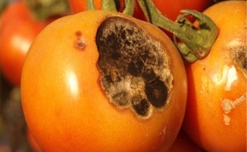Fungal diseases on tomato plant under greenhouse condition
Abstract
The cultivation of crops in the greenhouse is the most intensive form of horticultural production. Greenhouse climatic conditions provide an ideal condition for the development of many foliar, stem and soil-borne plant diseases. Diseases are a major limiting factor for vegetable that cause serious yield reduction leading to severe economic losses. Fungi enter plants through natural openings such as stomata and through wounds caused by pruning, harvesting, hail, insects, other diseases, and mechanical damage. This chapter provides an overview of the most important diseases of tomato plants. Some of the diseases that will cover in this chapter are the follow: Early blight late, Septoria leaf spot, Late blight, Fusarium wilt, Verticillium wilt, Anthracnose, Buckeye rot, and Southern blight. For each disease, main symptoms and disease development are described. This review is based on combined information derived from available literature and expertise knowledge.
Downloads
References
2. Kouyoumjian RE. Comparison of compost tea and biological fungicides for control of early blight in organic heirloom tomato production. MS Thesis. Clemson University, South Carolina, 2007.
3. Agricultural Marketing Service - National Organic Program. United States Department of Agriculture, 2010.
4. Tsror L. Biological control of early blight in tomatoes. Acta Horticult. 1999; 487: 271-273.
5. Vegetable MD Online. Department of Plant Pathology and Plant-Microbe Biology, Cornell University, 2010. http://vegetablemdonline.ppath.cornell.edu
6. Watson ME. Testing compost. Ohio State University Fact Sheet. ANR-15-03. Ohio State University Extension, 2003. http://ohioline.osu.edu/anr-fact/0015.html
7. Wszelaki A L, Miller S A. Determining the efficacy of disease management products in organically-produced tomatoes. Plant Health Progress, 2005. http://dx.doi.org/10.1094/PHP-2005-0713-01-RS
8. Jones JP. Early blight. In: Jones JB, Jones JP, Stall RE, Zitter TA, eds. Compendium of tomato diseases. American Phytopathological Society, St. Paul, MN, 1991: 13-14.
9. McGovern RJ, Davis TA, Seijo TE. Evaluation of fungicides for control of early blight and target spot in tomato. Fungicide Nematicide Test Reports. 1999; 55: 279.
10. McGovern RJ, Davis TA, Seijo TE. Evaluation of fungicides for control of early blight and target spot in tomato. Fungicide Nematicide Test Reports. 1999; 55: 280.
11. Sherf AF, MacNab AA, eds. Vegetable diseases and their control. John Wiley & Sons, New York, 1986.
12. Delahaut K, Stevenson W. Tomato disorders: early blight and Septoria leaf spot. University of Wisconsin Extension, Cooperative Extension Publishing. Disease fact sheet A2606, 2004.
13. Dixon GR. Pathogens of solanaceous crops. In: Vegetable crop diseases. AVI Publishing Company, Inc. Westport, Connecticut, 1981.
14. Hansen M A. Septoria leaf spot of tomato. Virginia Cooperative Extension Plant Disease Fact Sheet 450-711W. University of Maine Cooperative Extension, Orono, Maine, 2000.
15. Zitter TA. Septoria leaf spot of tomato (Septoria lycopersici). Cornell University, Department of Plant Pathology. Ithaca, NY, 1987.
16. Rowe RC, Miller SA, Riedel RM. Late blight of potato and tomato. Ohio State University Extension. Extension Fact Sheet HYG-3102-95, 1995.
17. Caldwell B, Rosen EB, Sideman E, Shelton A, Smart C. Resource guide for organic insect and disease management. New York State Agricultural Experiment Station, Geneva NY, 2005.
18. Jones JB, Jones JP, Stall RE, Zitter TA. Compendium of tomato diseases. The American Phytopathological Society, St. Paul MN, 1991.
19. Retig N, Rabinowitch HD, Cedar N. A simplified method for determining the resistance of tomato seedlings to Fusarium and Verticillium wilts. Phytoparasitica. 1973; 1(2): 111-114.
20. Fordyce C. Studies of the mechanism of variation of Verticillium albo-atrum. Diss Abstr. 1963; 23: 3584.
21. Caldwell B, Rosen EB, Sideman E, Shelton A, Smart C. Resource guide for organic insect and disease management. New York State Agricultural Experiment Station, Geneva NY, 2005.
22. Raudales RE, McSpadden-Gardener BB. Microbial biopesticides for the control of plant diseases in organic farming. The Ohio State University, publication HYG-3310-08, 2008.
23. Sherf AF, MacNab AA. Vegetable diseases and their control. 2nd edn. John Wiley & Sons, NY, 1986.
24. Jones JB, Jones JP, Stall RE, Brooklyn Botanic Garden. Natural disease control: A common-sense approach to plant first aid. Handbook #164. Brooklyn Botanic Garden, Inc. 1000 Washington Avenue, Brooklyn, NY, 2000.
25. CABI. Crop protection compendium. CAB International Publishing. Wallingford, UK, 2004.
26. Ploetz R. Compendium of tropical fruit diseases. APS Press, The American Phytopathological Society. Saint Paul, Minnesota, USA, 1998.
27. Thurston D. Tropical plant diseases. 2nd edn. APS Press. The American Phytopathological Society. St. Paul, Minnesota, USA, 1998.
28. Wagner G. Vegetables' pests. Personal Communication, 2004.
29. Baker RED. Notes on the diseases and fruit rots of tomatoes in the British West Indies. Trop Agr. 1939; 16: 252-257.
30. Sarejanni JA. La pourriture du collet des solanées cultivées et la classification du genre phytophthora. Beuaki Inst Phytopath. 1936: 35-52.
31. Young PA, Harrison AL, Alstatt GE. Common diseases of tomatoes. Tcx Agr Expt Sta Cir. 1940: 86-32.
32. Stevens NE, Nance NW. Spoilage of tomatoes in transit, as shown by inspection certificates. U. S. Dept. Agr. Cir. 1932: 245.
33. Poetbren van N. Verslag over de werkzaamheden van den plantenziektenkundigen dienst in het jaar 1924. Verslag. En Meded. Plantenziektenkund. Dienst Wageningen. 1924: 41-62.
34. Farr DF, Rossman AY. Fungal databases. Systematic Mycology and Microbiology Laboratory, ARS, USDA, 2016.
35. Sustainable disease management of cucurbit crops in the home garden. http://www2.ca.uky.edu/agcollege/plantpathology/ext_files/PPFShtml/PPFS-VG-19.pdf.
36. Vegetable production guide for commercial growers. http://www2.ca.uky.edu/agcomm/pubs/id/id36/id36.htm.


This work is licensed under a Creative Commons Attribution-NonCommercial 4.0 International License.




